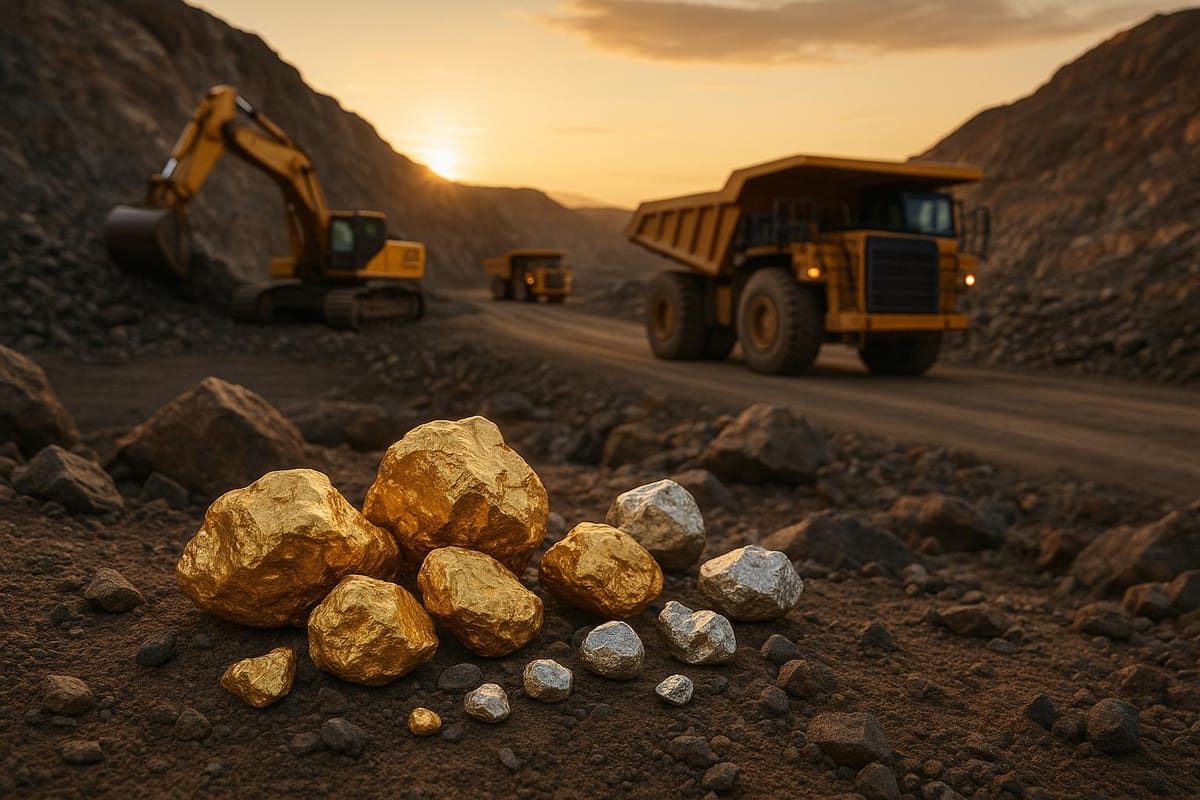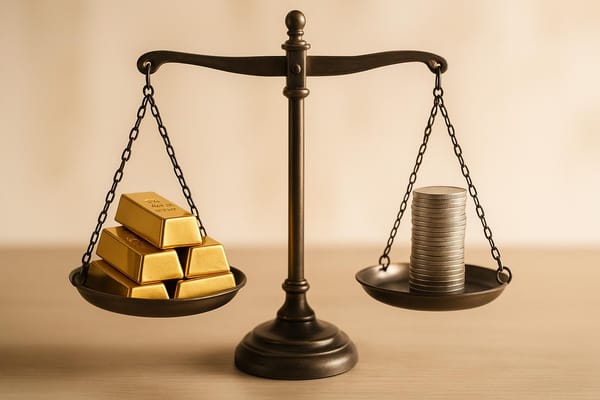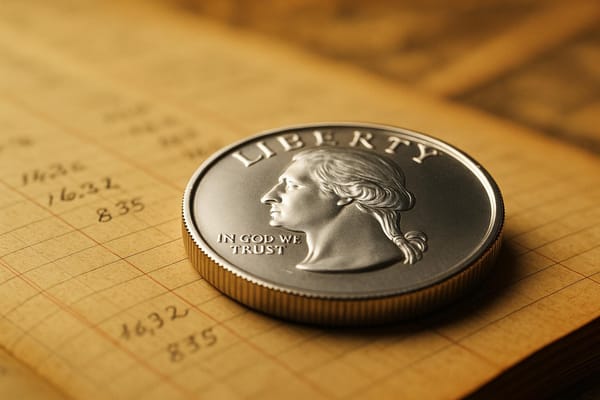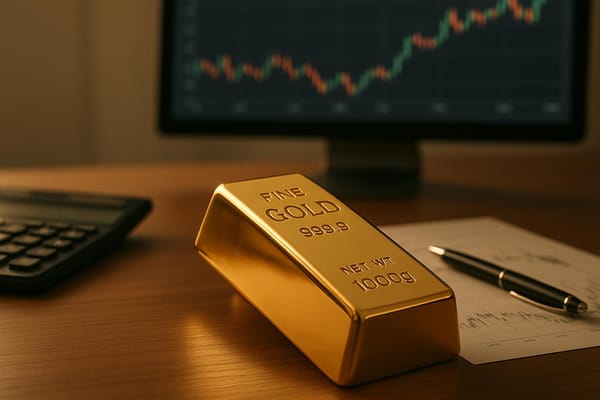Top 5 Factors Impacting Gold and Silver Supply
Explore the key factors affecting gold and silver supply, from mining challenges to recycling and demand pressures, in today's volatile market.

Gold and silver supply is influenced by five main factors, each creating unique challenges for the market:
- Mining Production Issues: Declining ore grades, rising extraction costs, and regulatory delays are slowing down production. Gold output has dropped by 7% (2016–2021), while silver fell by 8.5%.
- Government Policies: Trade tariffs, export restrictions, and geopolitical instability disrupt supply chains and drive up prices. For example, recent tariffs have pushed gold prices to $2,943.25/oz and silver to $36.37/oz.
- Recycling Sources: Recycled metals are filling supply gaps. Gold recycling contributes 33% of global supply, while silver recycling now covers 18%.
- Industrial and Investment Demand: Silver faces intense demand from sectors like solar energy and electronics, creating a persistent supply deficit. Gold, meanwhile, sees steady demand from jewelry and central banks.
- Stockpiles and Deficits: Shrinking reserves and ongoing deficits (e.g., a 150M oz shortfall in silver for 2025) are tightening supply further.
These factors highlight the complexity of managing precious metal supplies amidst rising demand and limited production growth.
Silver’s Supply Crisis Is Structural - Production Won’t Catch Demand for Years | Phil Baker
1. Mining Production Challenges
Mining operations are grappling with a host of challenges that are tightening the supply of gold and silver. One of the biggest hurdles is declining ore grades. Simply put, miners now have to process more rock to extract the same amount of precious metals. This shift drives up extraction costs and can make some deposits financially unviable.
In 2022, the cost of producing gold jumped by 18%, reaching $1,276 per ounce - well above the previous peak of $1,116 per ounce recorded in 2012. Silver production costs have also risen, with all-in sustaining costs ranging from $11.76 to $20.40 per ounce in 2023.
Even large producers are feeling the squeeze. In 2023, Newmont Corporation reported robust production numbers but still posted a net loss of $2.52 million. On the other hand, AngloGold Ashanti managed to turn a $1.03 billion profit, despite operating at a cost of $1,538 per ounce. This highlights how operational efficiency can sometimes offset rising production expenses.
Exploration difficulties add to the strain on supply. Mining companies are pouring more money into exploration efforts but are finding fewer economically viable deposits. This raises concerns about future supply as current mines approach the end of their lifespans.
The industry is also struggling with a severe talent shortage. Enrollment in mining-related degree programs has plummeted in countries like Canada and Australia. According to a 2024 World Economic Forum survey, 40% of mining employers believe that their ability to transform operations will be hampered by difficulties in attracting skilled workers. This shortage not only delays projects but also drives up labor costs.
Regulatory hurdles further complicate matters. Lengthy approval processes and rising taxes or royalties in certain regions make it harder and more expensive to bring new projects online.
These challenges are reflected in production trends. Between 2016 and 2021, gold mining output dropped by 7%, while silver production fell even more sharply, by 8.5%, despite strong metal prices during that period.
To tackle these issues, mining companies are turning to digital solutions. AI is being used to analyze geological data and satellite imagery, slashing exploration timelines by up to 30%. However, adopting these technologies comes with steep upfront costs and additional regulatory complexities.
2. Government Policies and Political Risks
Gold and silver markets are highly sensitive to government policies and political instability. Changes in export restrictions, trade policies, or unrest in key mining regions can quickly ripple through global markets, often within days. These shifts frequently compound existing market trends, making supply challenges even more pronounced.
One of the clearest examples of this is the impact of trade disputes and tariffs. In February 2025, the Trump administration imposed a new round of tariffs: 25% on imports from Canada and Mexico, and 10% on Chinese goods. Additionally, goods from China faced a staggering 145% tariff rate when entering the U.S.. These trade measures disrupted supply chains across industries, including precious metals.
"The implementation of tariffs brings a high level of uncertainty to the markets, and safe-haven products like gold and silver continue to do well." - David Meger, Director of Metals Trading at High Ridge Futures
Political instability in mining regions also poses a direct threat to supply. For instance, during the U.S.-Iran tensions in 2019, concerns about potential disruptions drove investors toward safe-haven assets. In just a few weeks, silver prices surged by over 15%. Such price movements highlight how quickly geopolitical volatility can unsettle supply chains.
Periods of political tension often bring a mix of rising oil prices, geopolitical risks, and supply chain disruptions. Export restrictions can further strain global supply, especially when major producers use them to safeguard local resources or as a political tool. These restrictions, when enacted suddenly, can tighten supply overnight.
History shows that trade barriers, such as tariffs, amplify market uncertainty. While the specifics of today’s economy differ, the fundamental principle remains: trade barriers push investors toward precious metals as a hedge against instability.
Recent trends reflect this dynamic. On February 11, 2025, gold prices hit an all-time high of $2,943.25 per ounce. Silver followed suit, trading at $36.37 per ounce - a 23.33% increase compared to the previous year. Meanwhile, China has been paying premiums of up to $39 per ounce for gold, underscoring how political tensions can distort regional pricing and supply.
Central bank policies add another layer of complexity. Amid de-dollarization efforts, central banks are shifting reserves, further tightening the supply of precious metals. These moves are not just economic decisions - they also reflect careful evaluations of political risks and the need for secure storage.
3. Recycling and Secondary Supply Sources
When mining production faces obstacles or demand for precious metals surges unexpectedly, secondary sources play a crucial role in maintaining supply. Recycled precious metals, particularly gold, have consistently bolstered global reserves. In fact, between 1995 and 2014, recycled gold made up roughly a third of the total gold supply worldwide. This contribution helps stabilize the market during periods of production shortfalls.
The recycling industry primarily operates through two key segments. First, there’s high-value recycled gold - jewelry, gold bars, and coins - which accounts for about 90% of all recycled gold. This type of recycling relies on well-established chemical and physical separation methods. On the other hand, industrial recycled gold, sourced from waste electrical and electronic equipment (WEEE), has grown significantly. A decade ago, it represented less than 5% of recycled gold; today, it makes up about 10%.
Recycling gold from jewelry is relatively straightforward, but recovering it from electronics is far more complex. Electronics often contain a mix of elements and chemicals that complicate the separation process. Additionally, the recycling chain for industrial gold is longer and more intricate than for high-value sources. These challenges make industrial recycling both a vital supply source and an area where advancements in technology could yield substantial benefits.
Interestingly, e-waste holds considerable potential for gold recovery. For example, one metric ton of mobile phones can contain up to 980 grams of gold, and printed circuit boards can yield approximately 420 grams per ton. In contrast, traditional mining operations typically extract just a few grams of gold per ton of ore. Beyond the economic advantages, recycling gold from WEEE significantly reduces environmental impact. Mining gold generates a carbon footprint of about 30,000 kg CO2-eq per kilogram, which is over ten times higher than the emissions from current WEEE recycling processes.
Some businesses, like Mazuma Mobile, have simplified recycling by offering cash incentives for old devices, combining economic benefits with efficient metal recovery. On an industrial scale, gold recovery from WEEE often involves pyrometallurgical copper smelting. However, challenges such as maintaining metal purity, managing intricate chemical separations, and controlling costs can affect the amount of recycled material entering the market. This makes secondary supply less predictable compared to traditional mining.
The rise in industrial recycling reflects both technological progress and the growing awareness of electronic waste as a valuable resource. As processing techniques improve and become more cost-efficient, recycled metals are poised to make up an even larger share of the overall supply. This shift not only helps address the limitations of primary mining but also highlights the evolving dynamics of precious metals supply.
4. Industrial and Investment Demand Pressures
Industrial and investment demand are putting a squeeze on the supply of precious metals, particularly silver. For silver, over half of its global demand comes from industrial applications, thanks to its unique properties that make it essential for a variety of industries.
Silver’s standout qualities - like excellent conductivity and antimicrobial properties - drive its use in electronics, solar panels, and medical devices. By 2025, experts predict global industrial silver demand will exceed 700 million ounces, creating fierce competition between industrial users and investors.
The solar energy sector has been a major game changer. Between 2015 and 2024, the share of silver used in photovoltaic applications more than tripled. Looking ahead, some forecasts even suggest that by 2050, solar energy could account for the entirety of silver demand. This rapid growth in industrial applications is adding significant pressure to a market already stretched by technological advancements and investment interest.
"We remain confident that in time, the use of artificial intelligence will grow to all sectors, and the resulting demand for semiconductor chips will drive strong demand growth for silver." – Ankita Amajuri, assistant economist at Capital Economics
Electronics remain a major driver of silver demand, as devices like smartphones, computers, and AI-powered technologies increasingly rely on it. Medical uses also play a consistent role, with silver’s antimicrobial properties being utilized in healthcare equipment, coatings, and medical devices. In 2024, silver saw a price jump of over 20%, reaching $35.82 per ounce by June 5, 2025 - the highest price since February 2012. This surge was fueled by both investment interest and optimism about its industrial potential.
"We have been expecting silver to close its performance gap with gold for some time. The metal has firm fundamentals, including being in a supply deficit and industrial demand being robust." – Nitesh Shah, commodities strategist at WisdomTree
Since 2019, the silver market has been in a persistent supply deficit, with demand consistently outstripping new supply from mining and recycling. This imbalance highlights the strain caused by rising industrial needs and growing investment pressures. Even though experts expect silver prices to climb by about 15% by 2025 due to strong industrial demand, higher prices haven’t necessarily led to increased production. That’s because silver is often mined as a by-product of other metals, making it harder to ramp up supply quickly.
Gold, on the other hand, faces less pressure from industrial demand. Most of its usage comes from jewelry and investment rather than industry. Still, gold competes with silver as a safe-haven asset for investors, though its price tends to be less affected by shifts in industrial demand.
The ongoing tug-of-war between industrial growth and investment demand continues to reshape silver’s market dynamics, forcing industries and investors to compete for an increasingly limited resource.
5. Existing Stockpiles and Market Shortfalls
The precious metals market is grappling with shrinking stockpiles and ongoing supply deficits, which continue to push prices upward. Silver, in particular, has faced annual supply shortages for several years, with projections indicating this trend will persist into 2025.
The Silver Institute forecasts a fifth consecutive year of deficit in 2025. Demand is expected to reach 1.20 billion ounces, while supply is predicted to grow by only 3%, hitting 1.05 billion ounces. This leaves a shortfall of roughly 150 million ounces, adding to a cumulative deficit of about 265 million ounces over recent years. The numbers showcase a clear imbalance between market demand and production capacity.
Institutional factors are also tightening supply chains. Central banks in countries like China, Russia, Turkey, and India are increasing their gold reserves amid global uncertainties, further limiting market availability and supporting higher prices. Daniel Pavilonis, a Senior Market Strategist, explains:
"Central bank purchases can support the price of gold by tightening supply if production doesn't keep pace."
When central banks buy gold, they effectively remove it from circulation, creating upward pressure on prices. Conversely, selling reserves can have the opposite effect, driving prices down.
In late 2024, anticipated tariff policies spurred traders to cover short positions, leading to a surge in silver deliveries to CME warehouses. This reflects the market's efforts to secure physical metal amidst growing supply concerns.
Commercial stockpiles are also feeling the strain. According to the Silver Institute's 2024 world silver survey, the global silver deficit is expected to grow by 17%, driven by a 2% increase in demand and a 1% decline in supply. While recycling efforts are projected to rise by 5% in 2025 - surpassing 200 million ounces for the first time since 2012 - this additional supply won't be enough to close the gap.
The current silver price, hovering around $36.07 per ounce, reflects these supply challenges. Experts believe the silver market will remain in deficit for the foreseeable future, fueled by rising demand from industries like renewable energy.
Gold, though less impacted by industrial use, faces its own pressures. Geopolitical uncertainties and trade policies have prompted central banks to increase their gold reserves, further tightening market supplies. Many countries see boosting gold holdings as a signal of confidence in its value, which drives demand and influences price trends. These stockpile challenges highlight the broader supply issues affecting both gold and silver markets.
Supply Factor Comparison Table
Gold and silver markets are shaped by a variety of supply sources, each contributing differently in terms of impact and reliability. These sources play distinct roles, and recent data highlights some key trends, particularly in the silver market.
For instance, silver mining output has seen a steady decline, dropping from 896.8 million ounces in 2015 to an estimated 823.5 million ounces in 2024. The most significant drop occurred in 2020, when production fell to 783.4 million ounces. On the other hand, recycling has become a more prominent source of silver supply, increasing from 147 million ounces in 2015 to a projected 178.9 million ounces in 2024. The table below provides a detailed breakdown of how various supply factors affect gold and silver.
| Supply Factor | Gold Impact | Silver Impact | Reliability | Growth Trend |
|---|---|---|---|---|
| Mining Production | Main contributor | Declining (823.5M oz in 2024 vs 896.8M oz in 2015) | Moderate – affected by ore quality | Declining |
| Recycling & Secondary Sources | Minor role | Growing importance (17.8% of supply by 2024) | High – responsive to price signals | Increasing |
| Government Policies | Influential through central bank purchases (1,136 metric tons in 2024) | Affected by trade policies | Low – subject to political changes | Variable |
| Existing Stockpiles | Serves as a buffer | Critical for covering a projected gap of 215M oz in 2025 | Low – finite reserves | Not specified |
| Industrial Demand Pressure | Limited industrial demand | Significant demand from electronics, solar, and medical uses | High – consistent need | Growing |
These comparisons highlight the unique challenges each metal faces. Gold's supply is heavily influenced by central bank activity and existing stockpiles, with approximately 200,000 tons above ground and an estimated 50,000 tons remaining underground. Demand from the jewelry sector accounts for about 50% of gold's annual consumption, while industrial use remains relatively small and stable.
Silver, however, faces structural deficits. A 215 million ounce gap is projected for 2025, which will likely be addressed by drawing down inventories. The Silver Institute estimates this will require a 28% reduction in current exchange stocks. Recycling has grown to 18% of global silver supply in 2023, and higher prices are expected to further boost recycling efforts, helping to offset mining shortfalls.
These dynamics explain why silver prices tend to fluctuate more than gold. Tightening supply conditions across various sources can drive prices higher for both metals, but silver's reliance on multiple, less stable supply channels makes it particularly sensitive to market changes.
Conclusion
The interplay of mining challenges, government policies, recycling efforts, demand pressures, and stockpile shortages has a profound influence on the supply and pricing of precious metals. Recycling and secondary sources have grown in importance, adding complexity to the supply equation. At the same time, industrial and investment demands continue to vie for these limited resources, with existing stockpiles acting as essential buffers during shortages.
Historical data highlights the strain on supply. For instance, in 2021, only 122 million ounces of silver were added to reserves, compared to 270 million ounces produced that year.
"Silver has a distinct duality pricing function that, at times, may be contradictory due to its industrial component and its monetary role." - Paul Wong, Colleague
Given these challenges, investors should closely monitor these factors to make informed decisions about market timing and portfolio adjustments. Federal Reserve policies, geopolitical developments, and shifts in industrial demand all point to potential volatility in the precious metals market.
Future projections suggest that supply pressures will only grow. Experts anticipate that silver demand for electric vehicles will eventually surpass its use in photovoltaic applications, further intensifying industrial competition. With precious metals often moving inversely to traditional assets like stocks and bonds, understanding these dynamics is crucial for diversifying portfolios during uncertain economic times.
At Gold and Silver.net, we stay ahead of these trends, providing investors with the insights they need to navigate the complexities of the gold and silver markets effectively. Understanding these supply factors is key to recognizing broader market patterns and opportunities.
FAQs
How do lower ore grades and higher mining costs affect the supply of gold and silver?
Declining ore grades and increasing mining costs are making it tougher to sustain the supply of gold and silver. When ore quality drops, miners have to process much larger volumes of material to extract the same amount of metal. This not only ramps up energy consumption but also drives operational costs higher.
These rising expenses can slow down production rates and, over time, could reduce the availability of these precious metals. As a result, prices may rise, potentially making gold and silver less affordable for both buyers and investors. On top of that, mining's environmental footprint may grow since extracting smaller amounts of metal requires more resources and effort.
How do geopolitical events and government policies affect the supply and pricing of gold and silver?
Geopolitical events and government policies have a big impact on the supply and pricing of gold and silver. When conflicts or international tensions arise, economic uncertainty often follows. In these situations, investors tend to flock to precious metals as a reliable safe haven, which pushes prices higher. On the flip side, when tensions ease, demand for gold and silver often drops, leading to lower prices.
Government actions also play a direct role in shaping the market. Policies like trade restrictions, mining regulations, or monetary decisions can significantly affect supply. For example, stricter mining laws can reduce production, limiting supply and potentially driving prices up. Similarly, measures like increased government spending or currency devaluation often lead to higher demand for gold and silver, as people seek protection against inflation. This, in turn, influences their market value.
How does recycling help reduce gold and silver supply shortages, and what recent advancements are improving this process?
Recycling plays an essential role in addressing the supply challenges of gold and silver by recovering these valuable metals from discarded items like electronics, jewelry, and industrial materials. By doing so, it helps balance the increasing demand with the limited output from mining, particularly during times when supply struggles to meet demand.
Advances in recycling technology, including AI-powered sorting systems and urban mining methods, are making the process more efficient and cost-effective. These breakthroughs enhance recovery rates, allowing more gold and silver to be extracted from recycled materials. As the demand for precious metals continues to grow, recycling is becoming a key component of the supply chain.



